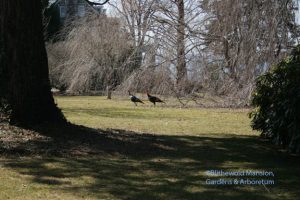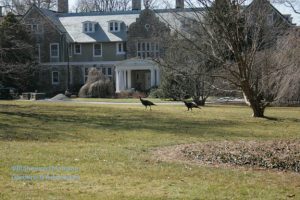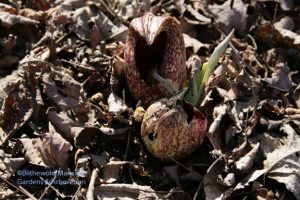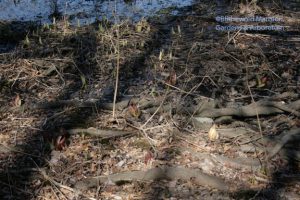Better than average
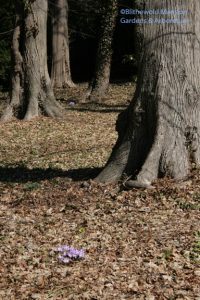 I’ve done a lot of grousing about March lately. And it’s almost as if she heard me and said “Oh yeah? You think I’m a drag? I’ll show you how awesome I can be!” Over the last couple of days, the weather has been beyond gorgeous. Quite a few visitors have taken advantage of bright beautiful days to wander the grounds. — But not all of the visitors, at least yesterday, were human. I’ve seen turkeys on the property before but never actual birds with feathers, wattles and all. A skittish trio strutted and lurched across the front lawn right in front of my camera. It looked like a female and 2 males – would that be a happy family or a hot chick with suitors? (My clearest shots only captured a pair – I think it was the female who stayed out of the frame.)
I’ve done a lot of grousing about March lately. And it’s almost as if she heard me and said “Oh yeah? You think I’m a drag? I’ll show you how awesome I can be!” Over the last couple of days, the weather has been beyond gorgeous. Quite a few visitors have taken advantage of bright beautiful days to wander the grounds. — But not all of the visitors, at least yesterday, were human. I’ve seen turkeys on the property before but never actual birds with feathers, wattles and all. A skittish trio strutted and lurched across the front lawn right in front of my camera. It looked like a female and 2 males – would that be a happy family or a hot chick with suitors? (My clearest shots only captured a pair – I think it was the female who stayed out of the frame.)
I’m usually on vacation in early March so I can’t tell from my stack of calendars/garden journals, but I have a memory – some vivid memories actually – of really awful weather right about now in recent years. (I know for sure that it was cold and rainy on the 8th two years ago. — Rain makes the knot tighter.) If I go by pictures, last year I took my first shots of skunk cabbage on the 13th. Either I was late spotting them or the skunk cabbage and crocus are early this year. By the looks of some of the skunk cabbage blooms, they may have been up for a while already. Anyone else keeping better track?
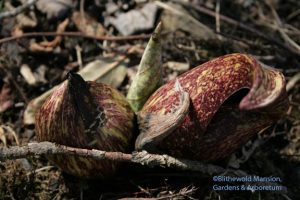 Skunk cabbage (Symplocarpus foetidus) is probably not my romantic ideal of a native wildflower but it is a fascinating creature. I didn’t know (before looking it up on the internet) that the flower, which is a spadix inside a spathe hood, produces heat. It’s one way of attracting pollinators – the other way being a foul odor (I did know about that). The heat they produce is also useful for busting through frozen ground earlier than almost anything else. Today’s pollinators were honeybees – I’m not sure I’d just love the taste of skunk cabbage honey but the bees will take what they can get this time of year and skunk cabbage knows it. Another fascinating thing is that the roots grow and then contract like muscles pulling the plant ever deeper into the ground. The older the plant the more deeply embedded. The pointy bud that shows alongside the bloom spathe, and should have been showing actually since the fall (though I never noticed it), is a spiral of leaves that will unfurl as the flowers wilt. To see skunk cabbage in action, look around swampy areas – most of ours are down by the water garden. It’s an eye test – all but the most solidly burgundy-colored are well camouflaged right now in the dapple and leaf debris.
Skunk cabbage (Symplocarpus foetidus) is probably not my romantic ideal of a native wildflower but it is a fascinating creature. I didn’t know (before looking it up on the internet) that the flower, which is a spadix inside a spathe hood, produces heat. It’s one way of attracting pollinators – the other way being a foul odor (I did know about that). The heat they produce is also useful for busting through frozen ground earlier than almost anything else. Today’s pollinators were honeybees – I’m not sure I’d just love the taste of skunk cabbage honey but the bees will take what they can get this time of year and skunk cabbage knows it. Another fascinating thing is that the roots grow and then contract like muscles pulling the plant ever deeper into the ground. The older the plant the more deeply embedded. The pointy bud that shows alongside the bloom spathe, and should have been showing actually since the fall (though I never noticed it), is a spiral of leaves that will unfurl as the flowers wilt. To see skunk cabbage in action, look around swampy areas – most of ours are down by the water garden. It’s an eye test – all but the most solidly burgundy-colored are well camouflaged right now in the dapple and leaf debris.
Have these last few days been better than average in your garden too?

